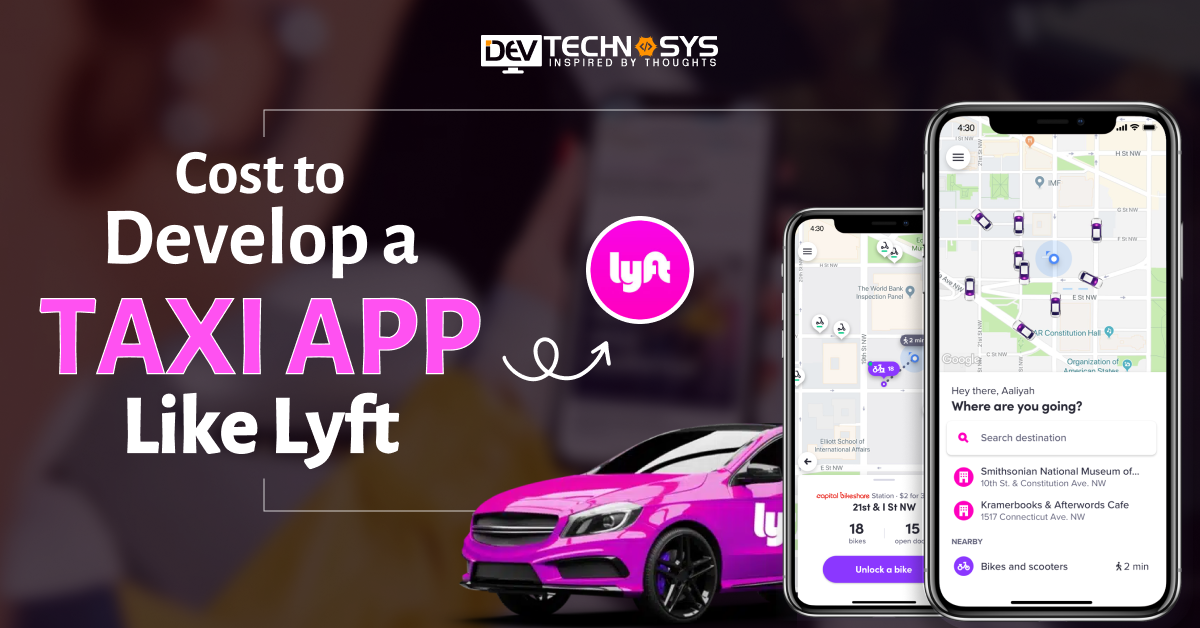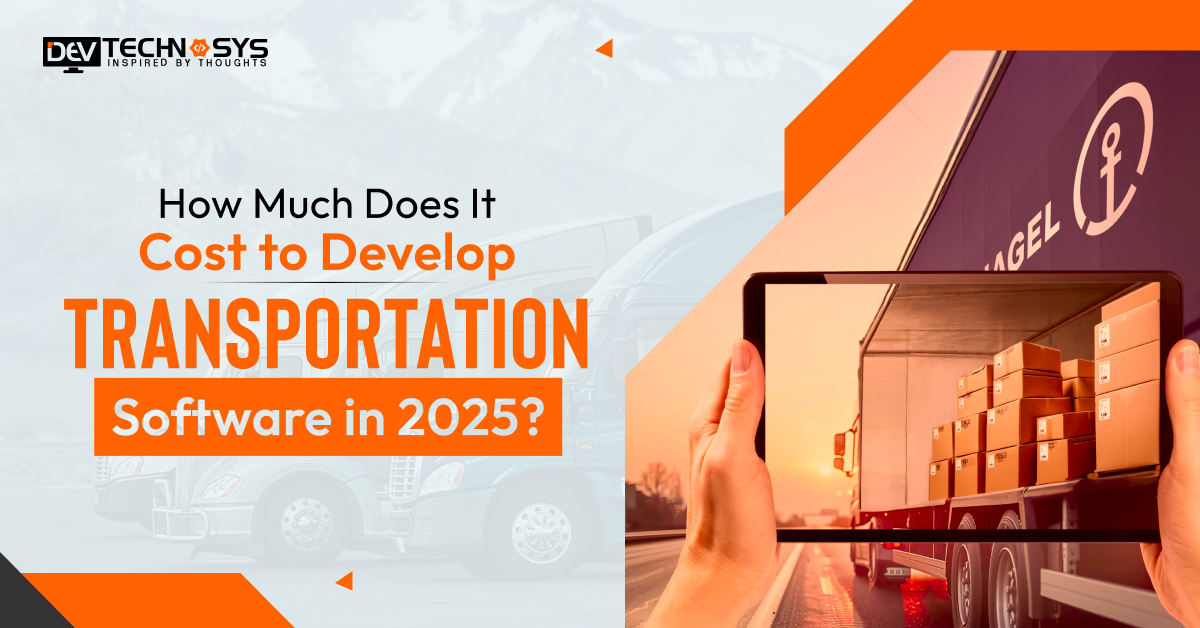Sharing and booking cabs have become a common trend among people due to their high accessibility and easy convenience. Car rental services are readily available for people through online websites and mobile applications. To facilitate the same, tech innovators assisted businesses to develop an app like Lyft that offers wonderful taxi booking solutions.
Based on a survey, around 67% of the total world’s population are involved in the taxi booking and car rental industry in some or the other manner. It had forced businesses to make different speculations to know the actual taxi booking app development cost.
Various aspects like cost factors, reducing strategies, monetization, and features are discussed in this blog. But, we are going to start by understanding the Lyft taxi app and looking at market stats of this industry.
What is Lyft?
Lyft is a car rental mobile app that connects passengers with drivers through online services. Founded in 2012, it operates primarily in the United States and Canada, offering convenient, on-demand transportation for individuals and groups. Lyft taxi allows users to choose from various ride options, such as standard, shared, or luxury vehicles, and provides fare estimates, real-time tracking, and in-app payment features.
Many Lyft alternatives are designed to offer a seamless experience for both passengers and drivers, facilitating easy communication and secure transactions. Lyft has become a popular alternative to traditional taxis, providing affordable and flexible transportation solutions. In addition to personal rides, it also offers services for businesses and provides options like Lyft Line for shared rides at lower costs.
Market Stats for the Taxi Booking Industry
- Revenue from the ride-hailing industry in the United Arab Emirates is anticipated to increase significantly, reaching a predicted $203.70 Million in 2025.
- By 2029, the market is expected to reach a volume of $254.50 Million, with a projected annual growth rate of 5.72% CAGR between 2025 and 2029.
- By 2029, there will likely be 4.74 million users in this industry, with a projected user penetration rate of 47.7% in 2029 and 40.4% in 2025.
- It is anticipated that the average revenue per user (ARPU) will be constant at $52.15.
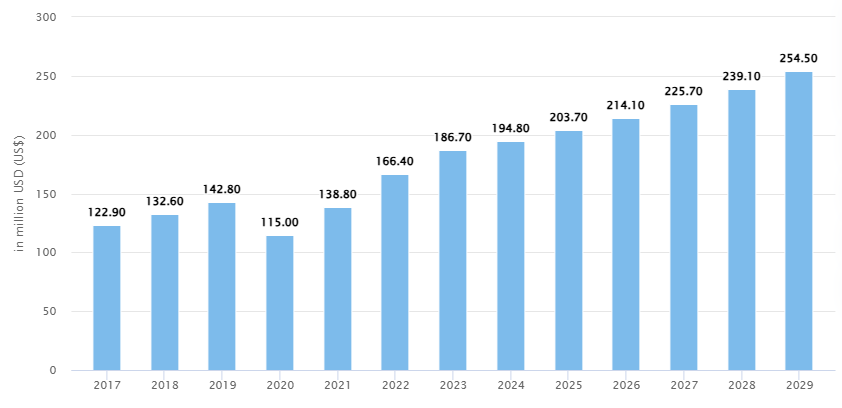
- Online sales are predicted to account for 100% of ride-hailing market income by 2029.
- With an anticipated revenue of $63,870 Million in 2025, China is estimated to produce the greatest revenue in this market when compared to other nations.
- Local competitors like Careem’s sibling business, Swvl, are posing a growing threat to ride-hailing giants like Uber and Careem in the United Arab Emirates.
What is the Cost to Develop an App Like Lyft?
The cost to develop an app like Lyft, a taxi rental platform is dependent on multiple market factors. In this section, we are discussing those factors with their estimated cost of Lyft taxi app development in detail:
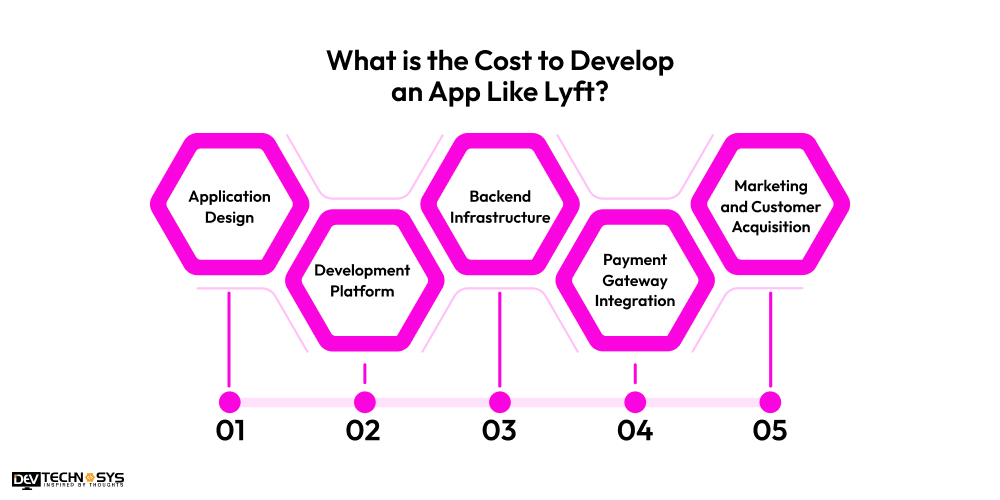
1. Application Design
Depending on how sophisticated the design is, the cost to develop a cab booking app like Lyft with a user interface that is both aesthetically pleasing and intuitive might vary significantly. Hiring a taxi booking app development company helps you to design layouts that are easy to use and navigate for both drivers and passengers. The cost of design also includes custom branding, animations, and visuals.
Design Strategy |
Estimated Cost |
| Basic | $10,000-$15,000 |
| Moderate | $15,000-$20,000 |
| Advanced | $20,000-$25,000 |
2. Development Platform
Because of the technological know-how needed, developing the app requires coding for both the iOS and Android platforms, which can be costly. Backend on-demand app development services are needed for features like real-time GPS tracking, ride scheduling, and payment integration. The long-term expenses are increased by ongoing upkeep and upgrades.
Development Platform |
Estimated Cost |
| iOS only | $25,000-$27,000 |
| Android Only | $20,000-$23,000 |
| iOS and Android | $25,000-$30,000 |
3. Backend Infrastructure
To manage massive data volumes and guarantee seamless operations, a full stack app development company should be contacted to build scalable and dependable backend.
This comprises cloud services for scalability, servers for data storage, and APIs for integrations such as maps, payments, and notifications. Businesses should hire Lyft taxi app developers to manage users and anticipated traffic to the app will determine the infrastructure cost.
Cost Factor |
Estimated Cost Range |
| Server Setup | $5,000 – $8,000 |
| Database Development | $2,000 – $3,000 |
| API Integration | $3,000 – $5,000 |
| Security and Encryption | $8,000 – $10,000 |
4. Payment Gateway Integration
Reliable payment gateway systems must be put up in order to integrate safe payment methods like digital wallets, credit/debit cards, and even cash payments.
Important factors that affect the total cost to develop a taxi booking app include transaction fees, security precautions, and adherence to financial regulations. Additionally, ongoing monitoring and improvements are necessary to ensure safe payment procedures.
Payment Integration |
Estimated Cost |
| Library Installation | $5,000-$10,000 |
| Key Encryption | $10,000-$12,000 |
| Link Code Generation | $12,000-$15,000 |
5. Marketing and Customer Acquisition
A sizable marketing expenditure is needed for campaigns, promotions, and brand awareness in order to increase users and draw in drivers and passengers.
It is beneficial to hire dedicated mobile app developers for managing the cost to build a taxi application like Lyft. Constant investment in client acquisition and retention tactics is necessary to maintain user growth.
Marketing Factor |
Estimated Cost |
| Sponsor Hiring | $5,000-$8,000 |
| Brand Advertisement | $8,000-$12,000 |
| Collaborative Framework | $12,000-$15,000 |
How to Reduce the Taxi Booking Application Development Cost?
To make the development process easy and effective, reducing the cost is very important. Let us discuss them with detailed information through reduction rate:
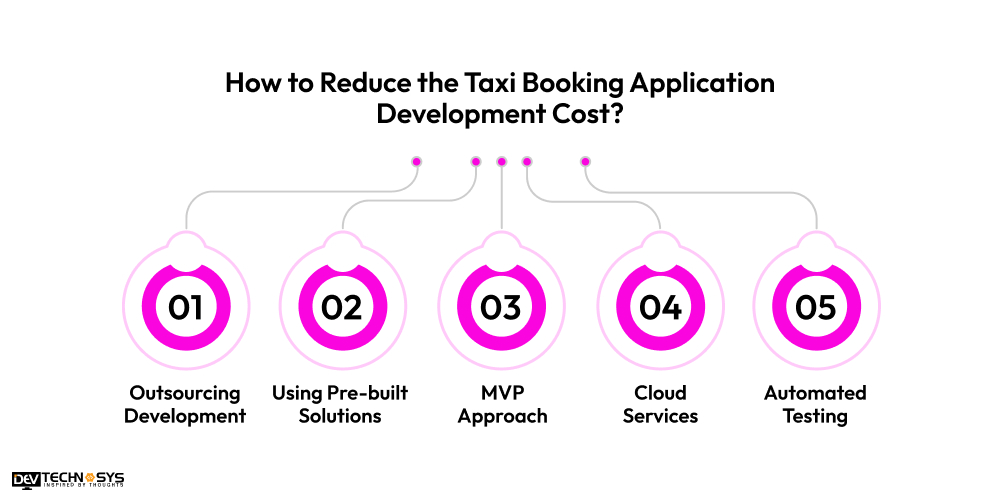
1. Outsourcing Development
Expenses can be greatly decreased by outsourcing Lyft taxi web application development to areas with cheaper labor prices. Costs can be reduced without sacrificing the quality of hybrid app development services from nations with cheaper hourly wages.
Method |
Percentage Cost Reduction |
| Outsourcing Development | 20% |
2. Using Pre-built Solutions
Time and Lyft taxi app clone development expenses can be decreased by utilizing mobile app development solutions like frameworks, libraries, and APIs for functions like GPS tracking and payment processing. Without starting from scratch, these solutions provide dependable, off-the-shelf functionality.
Method |
Percentage Cost Reduction |
| Using Pre-built Solutions | 15% |
3. MVP Approach
Initial costs can be decreased by creating a rudimentary version of the app with the most important functionality initially. You should hire dedicated taxi booking app developers to minimize software functionality in its early stages by allowing for user feedback and iteration after launch.
Method |
Percentage Cost Reduction |
| MVP Approach | 12% |
4. Cloud Infrastructure Services
Expensive infrastructure and taxi booking app development services is not necessary when using cloud platforms for server management and data storage. Additionally, cloud services enable scalability, which means that prices of Lyft taxi website development only rise in response to user demand.
Method |
Percentage Cost Reduction |
| Cloud Infrastructure Services | 10% |
5. Automated Testing
The process to create a cab booking app like Lyft is accelerated and manual testing is decreased through the use of Continuous Integration/Continuous Deployment (CI/CD) pipelines and automated testing. Because fewer mistakes and rework are made by a mobile app development company, testing and maintenance expenses are reduced overall.
Method |
Percentage Cost Reduction |
| Automated Testing | 7% |
Important Features of a Taxi Booking Applications
Car rental applications like Lyft taxi have multiple features that businesses can apply to make their applications more effective. Additionally, they can decrease the price. So, let us study different factors in this section:
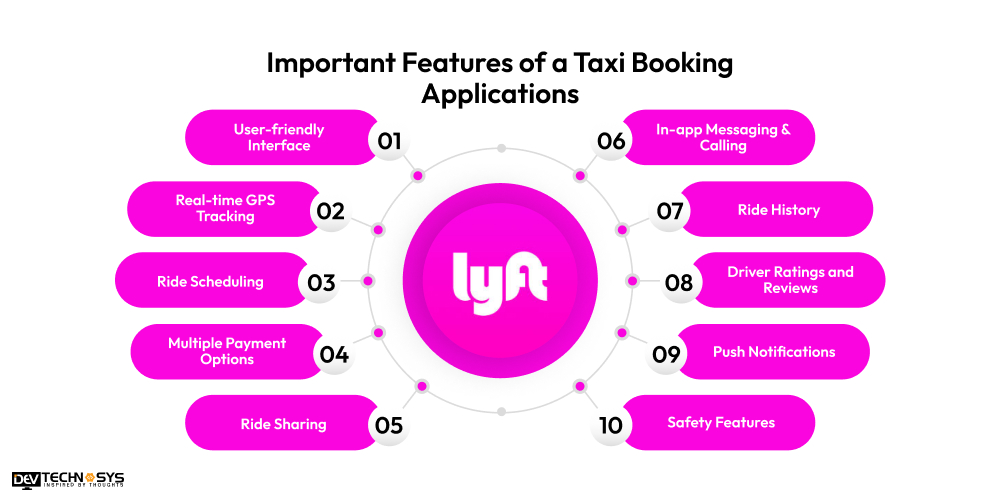
1. User-friendly Interface
Passengers can easily book a ride and utilize the app thanks to businesses investing money to develop an app like Yandex Taxi with simple design. It guarantees easy access to important functions including payment, travel history, and ride booking.
2. Real-time GPS Tracking
Real-time location tracking between drivers and passengers is possible through Lyft taxi app-like startup ideas. This function improves convenience and safety by guaranteeing on-time pickups and precise arrival estimates.
3. Ride Scheduling
Users have the option to book a ride in advance for a particular time on apps like Lyft. This option provides more flexibility to passengers with pre-arranged transportation needs.
4. Multiple Payment Options
By starting a taxi booking business in the UAE you can help people to use cash, digital wallets, and credit/debit cards for payments. This range guarantees that clients can choose from a number of convenient payment options.
5. Ride Sharing
Those who are traveling in the same direction may choose to ride together. Because there are fewer cars on the road, Lyft taxi app development in the UAE promotes sustainability and lowers travel expenses.
6. In-app Messaging and Calling
Different Android apps like Lyft facilitate direct communication between drivers and passengers. By eliminating the need to share private contact details, this function helps address problems like location misunderstanding.
7. Ride History
It is good to build an app like Hala Taxi that provides a thorough history of past rides, along with fee breakdowns, trip dates, and driver details, to users. This is helpful for analyzing previous experiences and keeping track of spending.
8. Driver Ratings and Reviews
Following a ride, customers have the option to assign a rating to their drivers. Through on-demand taxi services with the Lyft taxi app both drivers and passengers are held accountable by this feedback system, which also helps to maintain service quality.
9. Push Notifications
Real-time notifications on ride status, driver arrival times, and payment confirmations are sent to users by an iOS application like Lyft. These alerts enhance the overall experience of passengers and keep them informed.
10. Safety Features
You need to ensure safety in a ride sharing app for women by features including ride monitoring, an emergency button, and background checks on drivers. These steps promote confidence and give drivers and passengers peace of mind.
5 Important Methods to Monetize Apps Like Lyft
Earning methods are important for business investors so that they can balance the rate to develop an app like Lyft. In this section,we will explain a few monetization strategies:
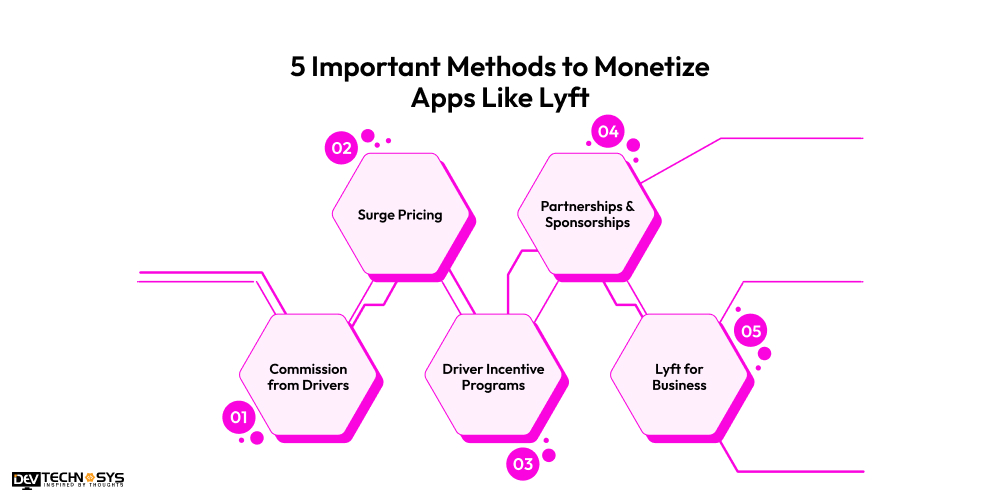
1. Commission from Drivers
The main source of income for a Lyft taxi is the proportion of each passenger fare that is paid. Usually after the process to build a cab booking app like Lyft is taken out of the driver’s pay, this commission guarantees the platform a steady stream of revenue. The location of an Android app development company and other variables may affect the percentage.
2. Surge Pricing
A Lyft like taxi booking app in Israel has the option to use surge pricing, which raises ride costs during periods of high demand. This encourages more drivers to become available and helps the business optimize earnings during busy times. Weather, time of day, and local events are some of the variables that might affect surge pricing.
3. Driver Incentive Programs
Drivers that reach specific ride quotas or receive excellent ratings may be eligible for bonuses or incentives from Lyft. By encouraging more drivers to remain active on the platform, implementation of iOS app development services may guarantee a consistent flow of rides. In exchange, it is profitable to create a Lyft taxi app clone that can increase the rider count and earnings from happy drivers and passengers.
4. Partnerships and Sponsorships
For advertising your brand after taxi app development, Lyft might partner with local companies or brands. You can make an app like Lyft for these collaborations may take the form of sponsored ride promotions, in-app advertisements, or special offers for users of particular services. This model is in practise for primary ride-sharing business.
5. Lyft for Business
Lyft can offer tailored solutions for companies that need transportation for their employees or clients. By contacting a website development company, businesses can provide bulk ride packages or corporate accounts to their users. This can include options like ride credits for employees or expense tracking for companies.
Recalling the Topics!!
We have covered important aspects related to the cost to develop a taxi booking app like Lyft such as different factors and their tables, reducing methods, features, and money-making strategies. They all are responsible to influence the development rate oppositely. Choice of factors may increase or decrease it, but other aspects always try to identify and fix the price in the budget.
This industry is demanding major car rental app development solutions to resolve consistent issues which you can give. The market is calling you to devote all your resources and time to develop an app like Lyft. So, that you can easily provide the required solutions and increase your business revenue through the development of such apps.
FAQs
Q1. What is Lyft?
- A well-known app-based transportation service, Lyft links drivers and riders for easy, on-demand rides.
- It provides rides in urban and suburban regions and mostly operates in the US and Canada.
- Fare estimates, ride tracking, in-app purchases, and a variety of ride options, including conventional, shared, and luxury cars, are just a few of the services that Lyft offers.
Q2. What is the Cost to Develop an App Like Lyft?
The cost of development might vary from $50,000 to $200,000, depending on the platform and features. Ongoing expenses for bug fixes, software updates, and server hosting. Set aside money for marketing and promotions to draw in drivers and users.
Q3. What are the ways to reduce the development cost for a taxi app like Lyft?
- MVP Approach: A Minimum Viable Product (MVP) with just essential functionality should be the first step.
- Outsourcing Development: Employing developers from places like Eastern Europe or India that have cheaper hourly rates.
- Use Open Source Libraries: For some functionalities, use open-source libraries to cut down on development time and expense.
Q4. How can I monetize a taxi app like Lyft?
- You can charge extra income on subscription plans.
- Provide drivers or users with premium services for extra perks like expedited ride booking.
- Businesses can show ads to generate more income, particularly if a lot of people use the app.
Q5. What are the key features that affect the cost of developing a taxi app like Lyft?
- User Profiles: A feature-rich user account system with payment and trip history capabilities.
- Real-Time GPS Tracking: Including real-time passenger and driver location tracking.
- Payment Integration: A variety of safe and convenient ways to pay, including mobile wallets, PayPal, and credit cards.
Q6. What steps are involved in developing a taxi app like Lyft?
- Market Research: To make sure your app satisfies user needs, research your competition and learn about user preferences.
- Wireframing & Design: Before beginning the app development process, create wireframes and UI/UX designs.
- Development & Testing: Create the app, including features like GPS and payment systems, then test it to make sure it’s good.



